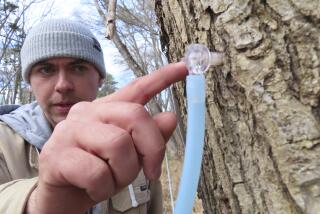SPIRITS : In Mint Condition : Julep Season Is Here, and It’s a Fine Time for Maker’s Mark
- Share via
WHENEVER I’M dining in New Orleans, I always order bread pudding with bourbon whiskey sauce for dessert. It’s an honest-to-goodness, truly American favorite. But somehow, the popularity of bourbon whiskey has been sliding for a decade. Vodka, rum and champagne show the only growth in sales of alcoholic beverages. I have been drinking Scotch for 50 years but I also like bourbon. And before you say that bourbon is old-fashioned, when did you last taste a fine Kentucky bourbon whiskey?
With summer here, now is the time to give bourbon another chance. A fine mint julep will not come amiss when entertaining. One such julep could be made with Maker’s Mark, which the Financial Times of London has declared to be “at the top end of the (bourbon) market.” Maker’s Mark is the smallest distillery in Kentucky but the only one designated a state and national historic landmark.
In 1780, what is now Kentucky was the westernmost county of Virginia. Gov. Patrick Henry, his hands full fighting the British, brought in additional settlers to handle Indian attacks from the west. He offered 63 acres to anyone who would come in, build a home on the land and plant the rest to Indian maize, the native grain. These historic “corn writs” worked out well, but the Kentucky wilderness had no access to markets. What to do with all that corn? Among the settlers were Scotch-Irish distillers from Pennsylvania who knew exactly what to do with it; they made whiskey, which could be floated down the Ohio and Mississippi rivers to New Orleans.
Among those early settlers--which included Robert Samuels from Londonderry, Ireland, great-great-grandfather of the current CEO, William Samuels Jr., of Maker’s Mark--was one Elijah Craig, a Scottish Presbyterian minister. The origins of bourbon begin with this pioneer. In 1789, for reasons unknown, Craig shipped to New Orleans whiskey in a barrel that had been charred on the inside. The only designation on the outside of the barrel was the county of origin, Bourbon. New Orleans customers went wild over the whiskey from that barrel. Traders began asking for “the Bourbon whiskey.” No one knew why, but it was better. The charring, plus the 60 - to 75 - day voyage down river, had given the “white lightning” finer complexity.
In 1953, William Samuels Sr., who came to the Hardin Creek area near Loretto, Ky., bought an old , run-down distillery, already once rebuilt in 1870, along with 240 acres of land . The fourth-generation Samuels intended to make a finer whiskey--better than any others.
Most distillers used corn, barley, wheat and rye. Wheat bread, Samuels reasoned, was softer on the palate than rye. So he eliminated the rye and emphasized the wheat. Samuels’ product raised eyebrows. It lacked the traditional “hard bite” of taste, substituting a mild glow that slides ever so gently away.
Today, Bill Samuels Jr., 48, a distiller and marketer, is the devoted follower of his father’s maverick course. And he has added his own touches in his quest for perfection. For example, walnut bungs (stoppers) with burlap wrappers offer workers access to barrels of aging whiskey so that samples can be withdrawn to determine when bottling can begin. Most distillers use stay-in-place poplar bungs.
New barrels are sent to the warmer upper floors of the rack houses for storage and later are moved down to cooler storage, to slow the aging process to the moment of bottling. All this care results in the translucent amber hue that has a flame-orange glint when the light hits it; the bouquet with scents of caramel and hints of vanilla from the charred oak; refreshing and complex flavor, rich but still soft and delicate, and, of course, that satisfying, noble finish.
Here is how to make a perfect mint julep, according to Bill Samuels.
Prepare the mint extract from a handful of fresh mint, using only tender leaves. Pour enough Maker’s Mark into a small bowl to cover the leaves and allow them to soak for 15 minutes. Transfer the leaves to a clean cotton cloth. Wring the mint bundle vigorously over the bowl of whiskey in which the leaves were soaked. Dip the bundle back into the liquid, wring it and repeat the procedure several times.
Prepare a simple syrup from equal amounts of sugar and water, heating it until the sugar dissolves. Cool.
Pour 3 1/2 parts of Maker’s Mark and one part syrup into a large bowl. Through taste and smell, gradually add the mint stock to the bowl until there is a soft aroma of mint.
Fill each julep cup with shaved ice. Insert a sprig of fresh mint. Pack in more ice to about an inch above the top of each cup and insert a short straw. When frost forms on the glass, pour refrigerated julep stock over the ice and sprinkle with powdered sugar (optional). Relax and enjoy this liquid showcase of the finest bourbon.
More to Read
Sign up for The Wild
We’ll help you find the best places to hike, bike and run, as well as the perfect silent spots for meditation and yoga.
You may occasionally receive promotional content from the Los Angeles Times.






